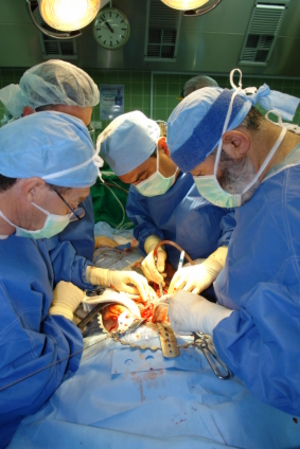The process of becoming a doctor is long and grueling but the journey can be very rewarding. Few professions have the ability to make such a large difference in the lives of others as physicians. In our society they are rewarded with both respect and good salaries for their hard work and dedication to curing disease and illness. The path to become a physician can be broken down to three stages; college, medical school and residency.
The first step is to receive a bachelor degree from an accredited four year university. Although there is no required major, pre-medical students often major in biology or chemistry. During your college education you will need to take the prerequisites for medical school, which consists of one year of Chemistry, Organic Chemistry, Biology and Physics. Each “year” is defined as two semesters of around 5 credit hours each such as Biology 101 and Biology 102.
While you are in college it is important to fill your Curriculum Vitae to help with the application process for medical school. Some important things the admission committee looks for are volunteer experiences, leadership positions, and research. Also helpful are awards and work experiences. You should also take the time to “shadow” or follow around a physician to two. This gives you an idea of what it is really like to be a doctor (hint: It’s not quite like Grey’s Anatomy!) and lets the admission committee know you’re serious. Some volunteer positions that pre-medical students often try are as helpers in emergency rooms, free health clinics, or other medical facilities.
During your last year of college you will usually take the MCAT (Medial College Admission Test). This is a three hour long that is designed to assess you knowledge in verbal reasoning, physical sciences and biological sciences. Each section is scored on a scale of one through fifteen, which are then added to give you a composite score. These sections are all standardized with an average score being eight. This means that not only are you battling the questions, but everyone else who is taking the test with you as well.
The next step is to apply to medical school which is done through a system called AMCAS (American College Application Service). This is a centralized depository of all your grades, your CV and your letters of recommendation. Once you have finalized your AMCAS application you can send a copy to any medical school you would like to apply to. Once the schools receive your application they will often send you a “secondary” application to fill and return. After the secondaries are received a committee will usually meet and offer interviews to applicants they are interested in.
After each applicant is interviewed, the committee will one again meet and decide whether to offer the student a position in the class, place the student on a “wait list” or to give the student a rejection. The wait list is used to keep the files of students they are interested active in case they are not able to fill the entire class. This process can be excruciatingly painful, with some students not finding they have been accepted off the wait list until a few days before the start of classes!
Medical school is the next phase of the aspiring physician’s training. This consists of four years, the first two which are considered “book years” are mostly taught in the classroom and the “ward years” which are spent in the hospital. During the book years classes usually run four to five hours a day with small groups and an occasional clinical experience throw in. Most students study three or four hours each night and often times much more before an exam. After you have finished the first two years you must take and pass an exam called Step 1. This is a seven hour test which contains 350 questions, and is one of the most important aspects of your residency application.
During the ward years, you will rotate through many different specialties including surgery, internal medicine, pediatrics, obstetrics/gynecology, and family practice. The time commitment of each rotation can be variable with some being only a few hours while others (such as surgery or OB/GYN) lasting 12+ hours. Medical students will also occasionally have to spend nights in the hospital to take “call” on their patients. At some point in their fourth year, you will also take the Step 2 test which must be passed before graduation. (This is a 400 question, 8 hour test.)
Near the middle of the fourth year you will also begin to apply for residency. This is similar to the medical school application process, with the applicant once again filing out an online application and sending it to programs they are interested in. This is where a medical student decides what type of specialty they are interested in; for example someone who would like to be a surgeon will apply to surgery residencies while someone who would like to be a pediatrician will apply to pediatric programs. As the residency programs receive the applications they offer invitations to interview.
Once the interviews are finished, each applicant will rank the programs that they interviewed at from their favorite to least favorite. Each residency program does the same thing and the lists are placed into a computer. On Match Day (March 15th) the computer attempts to combine the lists and match applicant’s top choices with the programs that ranked them the highest. It is a binding contract, so applicants are required to attend the program that they were “matched” into.
After graduating medical school (and now officially being called doctor!) the last part of the physicians training begins: residency. This lasts from three (internal medicine and family practice) to five years (surgery) with some programs taking as long as six or seven years (neurosurgery). During this time you work in a hospital under the supervision of an attending physician, learning hands on the skills and knowledge to be a fully licensed doctor. Depending on the specialty, you will often rotate though many different positions in the hospital, both in-patient and ambulatory settings. You will also be required to take Step 3, which is a two day test that consists of more then 500 questions.
Once residency is finished, you would then be able to become fully licensed and practice in which ever manner you pleased. From college to residency, the entire process takes from around 11 to 13 years to complete. Although this seems overwhelming at first it is quite doable and the process itself is very rewarding. If you are interested in learning more about becoming a physician, you can have a look at www.medwaderer.com or www.studentdoctor.com. More information about the application to medical school can be found at AMCAS.




